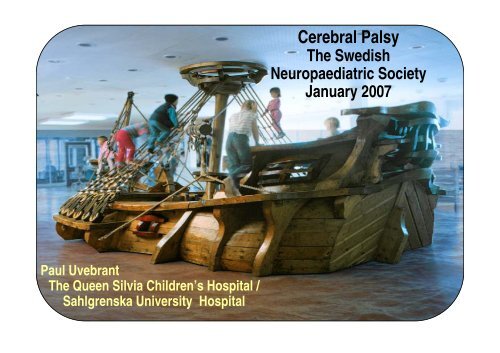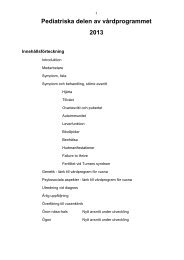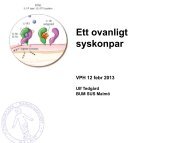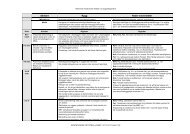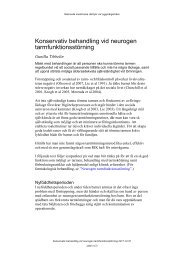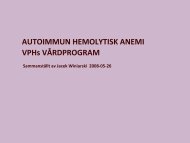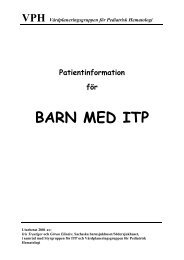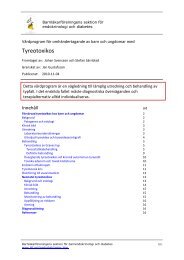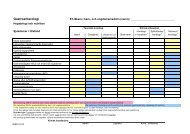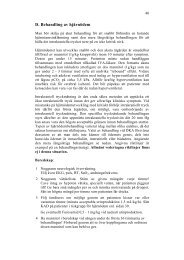Cerebral Palsy - BLF
Cerebral Palsy - BLF
Cerebral Palsy - BLF
Create successful ePaper yourself
Turn your PDF publications into a flip-book with our unique Google optimized e-Paper software.
CEREBRAL PALSY• A new definition• A new classification• Trends• Aetiology• Function
DEFINITION OF CEREBRAL PALSYAccording toSurveillance of <strong>Cerebral</strong> <strong>Palsy</strong>in Europe (SCPE)<strong>Cerebral</strong> palsy is an umbrella term for a group ofdisorders;is permanent but not unchanging;involves a disorder of movement and/or posture and ofmotor function;is due to a non progressiveinterference/lesion/abnormality of the developingimmature brain.
A NEW DEFINITION OF CEREBRAL PALSY“<strong>Cerebral</strong> palsy describes a group ofdevelopmental disorders of movement andposture, causing activity restriction or disability,that are attributed to disturbances occurring inthe fetal or infant brain.The motor impairment may be accompanied by aseizure disorder and by impairment ofsensation, cognition, communication and/orbehavior.”According tothe International Workshop on Definition and Classification of<strong>Cerebral</strong> <strong>Palsy</strong> Bethesda, Maryland, July 11-13 2004
A NEW CLASSIFICATION OFCEREBRAL PALSY• Spastic bilateral• Spastic unilateral(Diplegia)(Tetraplegia)(Hemiplegi)+ GMFCS I-V+ BFMF/MACS• Dyskinetic• AtaxiaDystonic (tonusväxling)Choreo-athetotic• Not classifiableSurveillance of <strong>Cerebral</strong> <strong>Palsy</strong> in Europe (SCPE2)
Gross Motor Function ClassificationSystem for <strong>Cerebral</strong> <strong>Palsy</strong>Robert Palisano, Peter Rosenbaum, Stephen Walter,Dianne Russell, Ellen Wood, Barbara GaluppInstitute for Applied Health Sciences, McMasterUniversity, Hamilton, Canada
Gross Motor Function Classification System• Level I: Walks without restrictions. Limitation inmore advanced gross motor skills.• Level II: Walks without restrictions. Limitationswalking outdoors and in the community.• Level III: Walks with assistive mobility devices,limitations walking outdoors and in the community.• Level IV: Self-mobility with limitations, children aretransported or use power mobility outdoors and inthe community.• Level V: Self-mobility is severely limited even withthe use of assistive technology.
A NEW CLASSIFICATION OFCEREBRAL PALSY• Spastic bilateralSpastic bilateral CP GMFCS Level V “children have nomeans of independent mobility and are transported.”corresponds roughly to “spastic tetraplegia”• Spastic unilateral (Hemiplegia)• Dyskinetic cerebral palsy - Dystonic- Choreo-athetotic• Ataxic cerebral palsy• Not classifiableSurveillance of <strong>Cerebral</strong> <strong>Palsy</strong> in Europe (SCPE2)
Den ”gamla” gruppen spastisk tetraplegiöverensstämmer mycket nära medden ”nya” gruppen bilateral spastisk CPGMFCS-nivå V.Några med sämre arm/handfunktion (eller likanedsatt) jämfört med benen, d.v.s vårtetraplegi definition, kan finnas på GMFCSnivåIV men när vi börjar lägga till bedömningav handfunktion i form av BFMF eller MACSså kan vi hitta dem också.
Accompanying impairments in CP• Mental retardation 45%,• Epilepsy 35%• Severe visual impairment 20%• Hydrocephalus 7%1009080706050403020100I II III IV VMentalretardationEpilepsyvisualimpairmentNo accompanying impairments 47%Figure 3. Proportion of mental retardation, epilepsy and severevisual impairment by GMFCS levels in 365 children born 1991-98.Himmelmann et al. Dev Med Child Neurol 2006
GMFM-kurvor för varje GMFCS-nivåGMFCS IGMFCS IIGMFCS IIIGMFCS IVGMFCS V
GMFM-kurvor för hemiplegi och diplegiGMFCS I-IIHEMIPLEGI IDIPLEGI IHEMIPLEGI IIDIPLEGI II
Pojke med hemiplegi GMFCS IBotulinumtoxin
<strong>Cerebral</strong> pares klassificeras ju i första hand vianeurologiska fynd somspastisk, dyskinetisk och ataktisk.Den spastiska formen kan vara unilateral(hemiplegi) eller bilateral (di-/tetraplegi) ochden dyskinetiska kan delas in i koreo-atetos ochtonusväxling.Vid blandformer anges den form somdominerar, det vill säga i första hand orsakarfunktionsnedsättningen.
Den nya klassifikationen avcerebral paresEn ”ny” klassifikationen av CP innebär i praktikenendast att en gradering av funktion läggs till.Denna gradering, med hjälp av det kanadensiskagrovmotoriska funktions klassifikations systemetGMFCS (Gross Motor Function ClassificationSystem) har visat sig mycket tillförlitligt ochenkelt och löser bland annat vårt problem att dragränsen mellan diplegi och tetraplegi som vållatså mycket internationell förvirring.
CP-typerSpastiskUnilateral HemiplegiBilateral Diplegi + GMFCS I-VTetraplegiDyskinetiskAtaxiKoreo-atetosTonusväxling
• Det går utmärkt att fortsätta att angediplegi och tetraplegi men vid bearbetningför framför allt internationella jämförelserslås dessa samman till bilateral spastiskCP som sedan ånyo delas upp i GMFCS´sfem nivåer (I-V)
GMFCS(Gross Motor Function Classification System)part of definitions for ages 4-6 yearsI – …...Children walk indoors and outdoors and climb stairs. Emerging ability to runand jump.II – …...Children walk without the need for any assistive mobility device indoors and forshort distances on level surfaces outdoors. Climb stairs holding onto railing but areunable to run or jump.III – ….Children walk with an assistive mobility device on level surfaces and climbstairs with assistance from an adult. Frequently transported when travelling forlong distances or outdoors on uneven terrain.IV –Children sit on a chair but need adaptive seating for trunk control and to maximizehand function, move in and out of chair sitting with assistance from an adult or astable surface to push or pull up on with their arms. May at best walk shortdistances with a walker …..V –…. .Functional limitations in sitting and standing are not fully compensated forthrough the use of adaptive equipment and assistive technology. No means ofindependent mobility and are transported. Some children achieve self-mobilityusing a power wheelchair with extensive adaptions.


